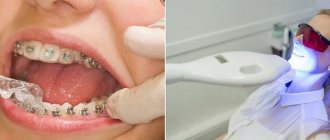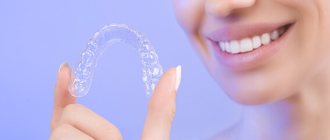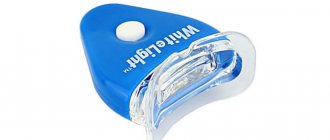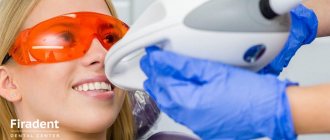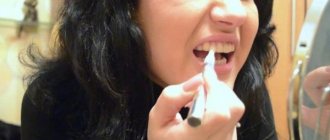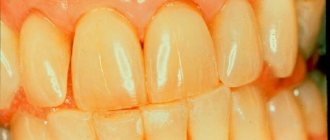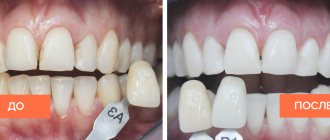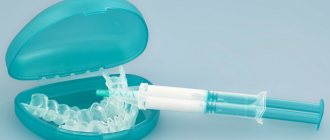How many days should you follow the diet? What can you not eat and drink? What can you do?
Example of a daily diet Other recommendations In the case of home whitening Who among us does not dream of a snow-white smile. Dentists have made such a dream accessible to almost everyone. It's easy to get a sparkling white smile, but how to maintain it?
One of the conditions is the diet after teeth whitening.
Why are restrictions needed?
After the procedure, tooth enamel:
- Becomes more sensitive
.
Over time, the increased sensitivity goes away, but in the first 48 hours
, the reaction to substances contained in food can be severe. - Even gentle manipulation increases its permeability
. Acids contained in some products may increase the risk of deterioration of the surface layer. - Becomes more porous
. The top layer of dentin is temporarily exposed. Pigments can easily penetrate it and stain it, ruining the entire procedure.
Hygienic care rules
Since the gums and dental tissues become more sensitive and weakened during the first few weeks, special hygiene requirements must be observed:
- Replacing the brush. Bacteria accumulate on the bristles over time, so it is recommended to change the dental plaque removal tool once every three months. After the whitening procedure, this must be done immediately, as the gums and enamel may be slightly injured. Even small cracks will become a path for pathogens to penetrate inside. You need to buy a brush with soft bristles, and after a few weeks replace it with a harder one.
- Competent selection of toothpaste. Products are chosen with low abrasiveness. This indicator indicates the strength of plaque abrasion, or, more simply, hardness. In the specifications it is indicated by the abbreviation RDA. It should be within 30 - 50 units. To strengthen the surface layer and saturate the enamel with microelements, pastes with fluoride or calcium are chosen. The higher the percentage of these substances, the better. If gum sensitivity is increased, then buy restorative gels with herbal extracts.
- Mouth rinses. After eating, be sure to rinse your mouth with clean water or mouthwash. If there is inflammation of the gums, use safe antiseptic solutions: Chlorhexidine, Miramestin, Rotokan. Do not rinse with herbal decoctions, as they can stain.
- Comprehensive care. To maintain hygiene at a high level, additional devices are used: interdental brushes, flosses, irrigators. If teeth have been additionally cleaned to remove supragingival or subgingival calculus, anti-inflammatory and regenerating drugs are applied to the gums, for example, Metragil Denta.
In order to always have white and healthy teeth, you need to undergo professional oral hygiene at the dentist once every six months.
How many days should you follow the “white diet” after teeth whitening?
The whitening process is not completed the moment the patient gets out of the chair. The effect needs to be consolidated. For this, certain restrictions are introduced. Very strict - for 48 hours, but dentists recommend not to take risks and stick to a “transparent” diet for 2 weeks
. So you will definitely amaze others with whiteness for many months. During this time, the tooth enamel will be restored and restrictions can be removed. Although it should be remembered that uncontrolled use of products with coloring pigments will cause the shine and sparkle of the enamel to fade quite quickly. But reasonable use, on the contrary, will prolong the effect.
Why do you need to eat this kind of food after the procedure?
The fact is that after the procedure the enamel becomes porous and more susceptible, including to dyes. The coloring pigment, which is found in a number of foods and drinks, easily penetrates and is absorbed into the lightened enamel.
In addition, after whitening, the enamel becomes more sensitive, so in the first few days after whitening you should avoid eating sour, hot and cold foods. You should also avoid eating too hard foods.
The most dangerous period is the first two days after the procedure. For the first 48 hours, you must strictly adhere to a white diet, and in subsequent days, consume unwanted foods in minimal quantities.
The longer the restriction from forbidden foods continues, the longer the result of the procedure will be.
What not to eat after teeth whitening
Darkening, pigmentation, and the appearance of spots are promoted by 3 factors: chromogens (substances that acquire color during oxidation), acids and tannins (tannins). They are found in many foods and can stain teeth, cause an unpleasant reaction, and even destroy enamel.
Products containing acids
- Citrus fruits e
. Even sweet tangerines contain a large amount of acid, which corrodes the protective layer. - Tomatoes
. They are not only red, but also sour. - Carbonated drinks
. They are carbonated with carbon monoxide, so even colorless carbonation is the enemy of enamel. - Fruit juices
. In terms of the amount of acids, they are comparable to carbonated drinks. - Pickles and marinades
. Vinegar is a strong acid that aggressively destroys surface layers.
Products containing acids
Products containing pigments
- Tea
(green and black),
coffee
. The tannins contained in these drinks have a cumulative effect. One cup may not stain your teeth, but there are no guarantees about the fifth. - Wine
. And white wine too. Red wine has a lot of coloring pigments, but any wine has acids. - Sweet carbonated drinks
are also included in this group. Most of them contain acids that destroy enamel, as well as pigments that leave stains on it. - Dark fruits and berries
. The combination of acids and pigments can ruin the whitening result. All red, blue, purple berries and fruits should go into oblivion for 2 weeks. - Chocolate
and colored candies. Sugar and pigments are a bad combination for tooth enamel. - Sauces
. Avoid soy sauce, balsamic vinegar, ketchup. Or better yet, any sauce at all. Most contain acids, tannins, pigments, or all three.
Products containing coloring pigments
It is better to heat-treat products that raise doubts.
Features of teeth whitening Zoom 4
Zoom technology is patented by Discus Dental. The essence of the method is as follows: a special gel is applied to the surface of the teeth, the action of which is activated by the light of an ultraviolet lamp. As a result of light exposure, oxygen molecules are released, which penetrate dental tissue and destroy coloring pigments.
Zoom 4 whitening technology, which is the latest version of Philips' development, features a number of solutions that significantly increase the comfort and safety of the procedure.
What is possible
Fortunately, the list of products allowed after whitening is quite extensive. It includes:
- White meat
(turkey, chicken),
fish
. They contain no acids or dyes. They provide us with protein without harm to health. - Tofu
. An excellent source of protein for vegetarians and vegans. - Dairy products
without dyes. Classic yogurt, milk without additives, cottage cheese, sour cream will provide you with the calcium you need after the intervention. - Cheeses. It is better to avoid exotic ones due to increased sensitivity.
- Cereals, pasta
and
bread
. Most cereals and pasta are allowed on the “white diet”. Problems can only arise with colored pasta or dumplings made from red flour. - Light fruits and berries
. They provide our body with vitamins. - Light vegetables
. Provide fiber without damaging teeth. - Water
. It definitely won’t leave dark spots or destroy the enamel. It's the best choice for hydration, oral health and a bright smile.
How does whitening with the Zoom 4 system work?
For the procedure to be effective, preparation for Zoom 4 teeth whitening involves professional hygiene. In order to prevent increased sensitivity of teeth, remineralizing therapy is also carried out in combination with brushing. One whitening session can consist of several cycles of 10-15 minutes. After whitening, Relief gel is applied to the enamel to reduce tooth sensitivity.
Approximate daily diet
Individual preferences influence what people eat after teeth whitening. A general recommendation would be to not drink alcohol. Wine contains tannins, and beer contains acids. Strong alcohol penetrates through the enamel pores, damaging the integrity of dentin. Therefore, it is better to exclude alcohol from the list of products for a white diet.
Breakfast
(options):
- porridge (with milk, with water);
- omelette;
- banana smoothie;
- buttered toast;
- classic yogurt;
- cottage cheese.
Dinner:
- mushroom soup;
- baked fish;
- potato;
- vegetable soup (avoid dark vegetables);
- poached chicken;
- chicken broth with dumplings.
Dinner:
- sandwich with chicken or cream cheese;
- pasta with white sauce;
- rice with chicken, fish, mushrooms;
- turkey salad;
- white beans;
- cauliflower.
Snacks:
- yogurt;
- baked apple;
- banana;
- cucumber;
- pear;
- white grapes.
By combining products and coming up with something of your own, you can easily survive for 2 weeks without noticing any restrictions.
It is important to ensure that the diet is complete, with a variety of recipes. For the body, the supply of vitamins and nutrients is important. Monotonous food and strict restrictions can lead to intestinal upset, vitamin deficiency, and demineralization of teeth.
On the other hand, you should not panic if you accidentally ate something that is not recommended to eat after whitening. Brush your teeth or rinse your mouth right away, the main thing is not to repeat the mistakes.
Nutrition principles:
- avoid “colored” foods;
- do not drink alcohol;
- to drink a lot of water;
- subject “doubtful products” to heat treatment.
The white diet is not limited to the list of foods that can be eaten after teeth whitening. The dentist will also give other care tips that will strengthen your teeth and prolong the duration of the procedure.
What else you need to know before whitening
1) Whitening only changes the color of natural teeth . Fillings, inlays, veneers and crowns cannot be bleached. If such restorations are located in the smile area and after whitening they differ in color from “your” teeth, ask your dentist to replace them.
For the same reason , teeth treated before whitening are closed with temporary fillings in order to later replace them with permanent ones (with the selection of the appropriate color).
Replacement of restorations is carried out no earlier than 14 days after completion of whitening (this is the average time it takes for the formation of a new teeth color).
2) Depulped (dead) teeth that have darkened after nerve removal can be whitened only by intracoronal bleaching . This procedure must be performed before teeth whitening.
3) It is impossible to accurately predict and order a specific color . The result of whitening is individual for each person and depends on many factors.
For example: gray-brown teeth whiten worse than white and yellow teeth. “Fangs” bleach worse than “incisors.”
Teeth may whiten unevenly (the necks of the teeth remain darker), but after some time the color of the teeth evens out. If this does not happen, you can lighten the unsatisfactory color with additional bleaching procedures.
The only option to ensure the desired color that is the same for all teeth is to install ceramic veneers on the teeth “in the smile zone.”
What else
Recommendations after teeth whitening:
- Refrain from eating
for
2 hours
, give your body a chance to recover - Avoid cold and hot
. After dental procedures, sensitivity increases. Warm food will help avoid discomfort. - For some time after the procedure, you should brush your teeth after every meal.
- Dental floss
helps remove food debris that, when decomposed, can cause tooth decay and damage enamel. - Do not use whitening
toothpaste until sensitivity returns to normal. Then it can be used to maintain the effect 1-2 times a week. - If you don't have the strength to give up caffeine, use a straw.
But it is better not to drink it after bleaching for at least 48 hours.
The result of whitening in ROOTT dentistry
Benefits of Philips Zoom 4 Teeth Whitening
The most effective and gentle whitening - under this motto, Philips launched its new product on the market. The Zoom 4 kit includes an LED lamp with various intensity settings, Philips ZOOM! Chairside, as well as Relief ACP tooth sensitivity reducer. Previous generation systems have a similar set of components. However, the old composition of the whitening gel could not be called ideal. In Zoom 4 it was seriously improved, which helped reduce the negative impact on dental tissue.
Is Zoom 4 teeth whitening harmful?
Any type of whitening is safe if it is performed by a qualified professional following protocol, as well as certified equipment and supplies.
pros
- The hydrogen peroxide content is 25%, which is the lowest level compared to previous Zoom systems.
- The whitening gel contains calcium phosphate to restore enamel.
- Philips ZOOM! Chairside does not overheat dental tissue and has a flexible system of settings.
- To prevent tooth sensitivity, an effective remedy is used - Relief ACP gel.
- The procedure takes on average no more than 45 minutes.
Do you want your teeth to become even whiter?
Dental clinic "Restoration" offers teeth whitening services. By contacting us, each patient will receive an individual approach, high-quality procedures using modern equipment and materials. Doctors with extensive experience, candidates of medical sciences, and leading Moscow specialists work here . We offer not only teeth whitening, the price of which is quite affordable, but also other procedures for treatment, implantation, prosthetics and many others.
At the Restavraciya clinic, the price for teeth whitening in Moscow is calculated individually for each patient. After examining the oral cavity, the specialist will offer the best option, which will return a snow-white and beautiful smile in just one visit to the doctor. You can make an appointment by phone or by filling out the form on the website. The clinic administrator will answer all questions, familiarize you with prices, and select a convenient time to visit the clinic. We value every client and care about our reputation, so we offer only effective and high-quality procedures.
Causes of discomfort
If your teeth hurt very badly after whitening, you did not eat food, did not violate the dentist’s recommendations, and the discomfort does not stop, there may be several reasons:
- an error when choosing a technique or when calculating the dosage of a lightening agent;
- using aggressive “home” remedies to enhance the effect - lemon juice, soda, salt - all these products from “grandmother’s chest” can damage the tooth or gum surface and cause infection;
- inflammation - occurs if the procedure was carried out for caries, periodontal disease, or if plaque was poorly removed;
- lightening in the presence of contraindications;
- chips, cracks in the enamel, dental pathologies can cause severe pain in the teeth after whitening, what to do in this case - the most reasonable thing is to consult a doctor;
- the presence of leaky fillings, exposure of necks and roots with advanced periodontal disease.
After lightening, you should avoid hot, cold, and spicy foods for at least a few hours - they can also cause pain.

